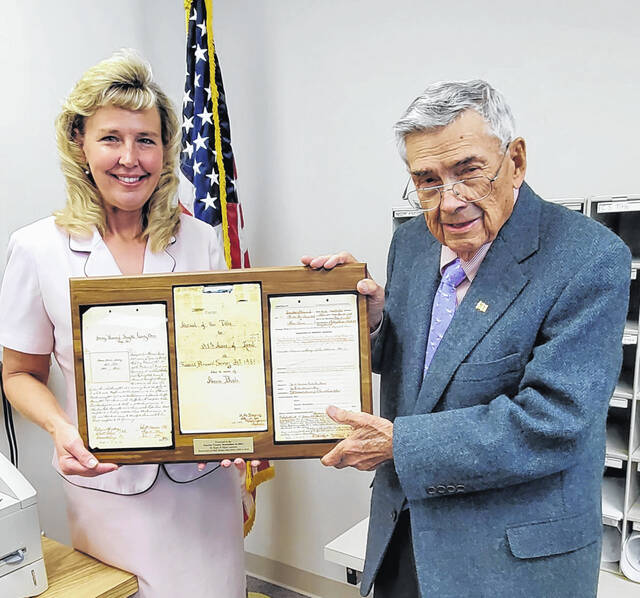
An extraordinary piece of county history is now on display at the Fayette County Recorder’s Office.
County recorder Kim Coil-Butler recently received a plaque from James A. (Jim) Kiger, attorney, containing three pages from a historical abstract for 1,000 acres of land surveyed in 1798 for Thomas Brown (also known as Thomas Bowne). The plaque was designed by Quali-Tee Design, a local home-owned company.
Coil-Butler said that Kiger had saved this document in the files of Kiger & Kiger after coming into possession of it back in the 1960s while he was doing land title work for the Washington Savings Bank, which was located at the corner of Court and Fayette streets. She added that Kiger generously spent time with her in order to help her familiarize herself with this piece of history.
According to information within the abstract and shared by Kiger, it is believed that Brown could have been a Revolutionary War veteran and the 1,000 acres were payment for military service to our country. The survey referenced military warrant 64 on the waters of Paint Creek, beginning at an elm, mulberry, and hickory, ending 400 poles.
Later, Brown could not pay the taxes and the land was sold at a sheriff’s sale where Wade Loofborrow, for the consideration of $1.06 per acre, bought the acreage. Loofborrow was the first prosecuting attorney of Fayette County. Apparently, Loofborrow became dissatisfied with the title to the 1,000 acres and sought the help of higher authorities by obtaining a deed from President Martin Van Buren, who acknowledged that the 1,000 acres had been deeded to Thomas Brown in 1790, which he later lost the land in 1829.
The curative deed from President Van Buren’s office is dated Dec. 10, 1839, however, it was not recorded until May 17, 1885. This deed was made to Thomas Brown, and referenced his service to our country, even though he had lost the land some 50 years before.
Coil-Butler said the recorder’s office is the repository of the recorded land records of Fayette County, Ohio. In these old deeds lies the history of how our country was settled by Revolutionary War veterans which were given the land as payment for their services, when the Continental Congress could not pay them in cash.
The records begin with Book A and continue through the digital age. Kiger said that at one time there was a file cabinet in the law library upstairs behind the courtroom in the main courthouse containing several of those old historical abstracts. Whatever happened to them he does not know.
Coil-Butler concluded by expressing her gratitude to Kiger for sharing his time and knowledge about this piece of history and for allowing the recorder’s office the privilege of hosting this plaque and the abstract for citizens and visitors to view and gain a better insight into our history.
She also added a reminder that it is important, once your deeds and other documents have been recorded, that you should keep them in a safe place so they are available when needed. However, you may always obtain a copy from the recorder’s office or online website. When you are in the recorder’s office, you are encouraged to view this extraordinary piece of Fayette County history.
Kiger thanked Coil-Butler and the Fayette County Commissioners for accepting these historical documents, saying that one can almost visualize what these Revolutionary War veterans and their families went through to settle on this land, establish the City of Washington Court House and surrounding villages, leaving all of us a priceless heritage.


